Adaptation of a Differential Scanning Calorimeter for Simultaneous Electromagnetic Measurements
Abstract
1. Introduction
2. Materials and Methods
2.1. Development of Electromagnetic Measurement System and Modification of DSC
2.2. Sample Preparation
3. Results
3.1. Room Temperature Tests
3.2. High Temperature Test on Nickel Sample
4. Discussion and Conclusions
Author Contributions
Funding
Institutional Review Board Statement
Informed Consent Statement
Data Availability Statement
Acknowledgments
Conflicts of Interest
References
- Zhou, L.; Wu, F.; Hall, R.; Davis, C. Electromagnetic sensors for in-situ dynamic microstructure monitoring of recovery and recrystallisation in interstitial free steels. J. Magn. Magn. Mater. 2022, 551, 169187. [Google Scholar] [CrossRef]
- Zhou, L.; Davis, C.; Kok, P. Steel microstructure–Magnetic permeability modelling: The effect of ferrite grain size and phase fraction. J. Magn. Magn. Mater. 2021, 519, 167439. [Google Scholar] [CrossRef]
- Dickinson, S.J.; Binns, R.; Yin, W.; Davis, C.; Peyton, A.J. The development of a multifrequency electromagnetic instrument for monitoring the phase transformation of hot strip steel. IEEE Trans. Instrum. Meas. 2007, 56, 879–886. [Google Scholar] [CrossRef]
- Skarlatos, A.; Miorelli, R.; Reboud, C.; Van Den Berg, F. Magnetic characterization of steel strips using transient field measurements: Global sensitivity analysis and regression from a machine-learning perspective. Inverse Probl. 2024, 40, 45012. [Google Scholar] [CrossRef]
- van den Berg, F.; Aarnts, M.; Yang, H.; Melzer, S.; Fintelman, D.; Ennis, B.; Gillgren, L.; Jorge-Badiola, D.; Martínez-De-Guerenu, A.; Davis, C.; et al. How the EU project “Online Microstructure Analytics” advances inline sensing of microstructure during steel manufacturing. In Proceedings of the European Conference on Non-Destructive Testing (ECNDT), Lisbon, Portugal, 3–7 July 2023. [Google Scholar] [CrossRef]
- Hu, C.; Wang, C.; Ma, X.; Zhu, Z.; Jiang, P.; Mi, G. EBSD study on magnetic field altering crystal texture and grain growth during laser-hybrid welding. Mater. Des. 2022, 216, 110587. [Google Scholar] [CrossRef]
- Janda, A.; Ebenbauer, S.; Prestl, A.; Siller, I.; Clemens, H.; Spoerk-Erdely, P. In-situ high-temperature EBSD characterization during a solution heat treatment of hot-rolled Ti-6Al-4V. Mater. Charact. 2022, 192, 112207. [Google Scholar] [CrossRef]
- Guillou, F.; Hardy, V. Burst-like features observed from different techniques at the first-order magnetic transition of La (Fe, Co, Si) 13. J. Alloys Compd. 2024, 977, 173161. [Google Scholar] [CrossRef]
- Hey, J.M.; Mehl, P.M.; Macfarlane, D.R. A combined differential scanning calorimeter-optical video microscope for crystallization studies. J. Therm. Anal. Calorim. 1997, 49, 991–998. [Google Scholar] [CrossRef]
- Hechu, K.; Slater, C.; Santillana, B.; Clark, S.; Sridhar, S. A novel approach for interpreting the solidification behaviour of peritectic steels by combining CSLM and DSC. Mater. Charact. 2017, 133, 25–32. [Google Scholar] [CrossRef]
- Nascimento, A.L.C.S.; Ashton, G.P.; Parkes, G.M.B.; Ekawa, B.; Fernandes, R.P.; Carvalho, A.C.S.; Ionashiro, M.; Caires, F.J. Novel solid-state compounds of heavy rare-earth (III) picolinates. A pyrolytic study using: TG-DSC-IR, HSM-MS and GC-MS. J. Anal. Appl. Pyrolysis 2019, 144, 104709. [Google Scholar] [CrossRef]
- Morra, P.V.; Böttger, A.J.; Mittemeijer, E.J. Decomposition of iron-based martensite. A kinetic analysis by means of differential scanning calorimetry and dilatometry. J. Therm. Anal. Calorim. 2001, 64, 905–914. [Google Scholar] [CrossRef]
- Schick, C. Differential scanning calorimetry (DSC) of semicrystalline polymers. Anal. Bioanal. Chem. 2009, 395, 1589–1611. [Google Scholar] [CrossRef] [PubMed]
- Sanlialp, M.; Molin, C.; Shvartsman, V.V.; Gebhardt, S.; Lupascu, D.C. Modified differential scanning calorimeter for direct electrocaloric measurements. IEEE Trans. Ultrason. Ferroelectr. Freq. Control. 2016, 63, 1690–1696. [Google Scholar] [CrossRef] [PubMed]
- Wielgosz, E.; Kargul, T. Differential scanning calorimetry study of peritectic steel grades. J. Therm. Anal. Calorim. 2015, 119, 1547–1553. [Google Scholar] [CrossRef]
- Raju, S.; Ganesh, B.J.; Banerjee, A.; Mohandas, E. Characterisation of thermal stability and phase transformation energetics in tempered 9Cr–1Mo steel using drop and differential scanning calorimetry. Mater. Sci. Eng. A 2007, 465, 29–37. [Google Scholar] [CrossRef]
- Khodabakhshi, F.; Kazeminezhad, M. Differential scanning calorimetry study of constrained groove pressed low carbon steel: Recovery, recrystallisation and ferrite to austenite phase transformation. Mater. Sci. Technol. 2014, 30, 765–773. [Google Scholar] [CrossRef]
- Bernhard, M.; Fuchs, N.; Presoly, P.; Angerer, P.; Friessnegger, B.; Bernhard, C. Characterization of the γ-loop in the Fe-P system by coupling DSC and HT-LSCM with complementary in-situ experimental techniques. Mater. Charact. 2021, 174, 111030. [Google Scholar] [CrossRef]
- Ren, L.; Zhu, J.; Nan, L.; Yang, K. Differential scanning calorimetry analysis on Cu precipitation in a high Cu austenitic stainless steel. Mater. Des. 2011, 32, 3980–3985. [Google Scholar] [CrossRef]
- Rowolt, C.; Milkereit, B.; Springer, A.; Kreyenschulte, C.; Kessler, O. Dissolution and precipitation of copper-rich phases during heating and cooling of precipitation-hardening steel X5CrNiCuNb16-4 (17-4 PH). J. Mater. Sci. 2020, 55, 13244–13257. [Google Scholar] [CrossRef]
- Liu, H.; Du, C.; Lan, P.; Tang, H.; Shang, C.; Zhang, J. Simultaneous formation of inter-and intragranular ferrite in microalloyed steels studied by modeling and experiment. Met. Res. Technol. 2017, 114, 401. [Google Scholar] [CrossRef]
- Wu, S.; Zhang, C.; Zhu, L.; Zhang, Q.; Ma, X. In-depth analysis of intragranular acicular ferrite three-dimensional morphology. Scr. Mater. 2020, 185, 61–65. [Google Scholar] [CrossRef]
- Hu, J.; Cao, W.; Wang, C.; Dong, H.; Li, J. Phase transformation behavior of cold rolled 0.1 C–5Mn steel during heating process studied by differential scanning calorimetry. Mater. Sci. Eng. A 2015, 636, 108–116. [Google Scholar] [CrossRef]
- Zhou, L.; Jacobs, W.; Wu, F.; Jolfaei, M.; Davis, C.L. In-situ dynamic monitoring of phase transformation in steels using a multi-frequency electromagnetic sensor. NDT E Int. 2023, 139, 102918. [Google Scholar] [CrossRef]
- TA Instruments. 2012, Q Series DSC Brochure. Available online: https://www.tainstruments.com/pdf/brochure/2012%20DSC%20Brochure%20r1.pdf (accessed on 3 April 2024).
- Texas Instruments. TMS320F2837xD Dual-Core Real-Time Microcontrollers; Texas Instruments: Dallas, TX, USA, 2024. [Google Scholar]
- Saunders, N.; Guo, U.K.Z.; Li, X.; Miodownik, A.P.; Schillé, J.P. Using JMatPro to model materials properties and behavior. JOM 2003, 55, 60–65. [Google Scholar] [CrossRef]
- Legendre, B.; Sghaier, M. Curie temperature of nickel. J. Therm. Anal. Calorim. 2011, 105, 141–143. [Google Scholar] [CrossRef]
- TA Instruments, Investigation of the Curie Point by MDSC. Available online: https://www.tainstruments.com/pdf/literature/TS28.pdf (accessed on 30 July 2024).
- Sales, B.C.; Maple, M.B. Low-frequency electrical resistance of iron, cobalt, and nickel in the vicinity of their Curie temperatures. Appl. Phys. A 1983, 31, 115–117. [Google Scholar] [CrossRef]


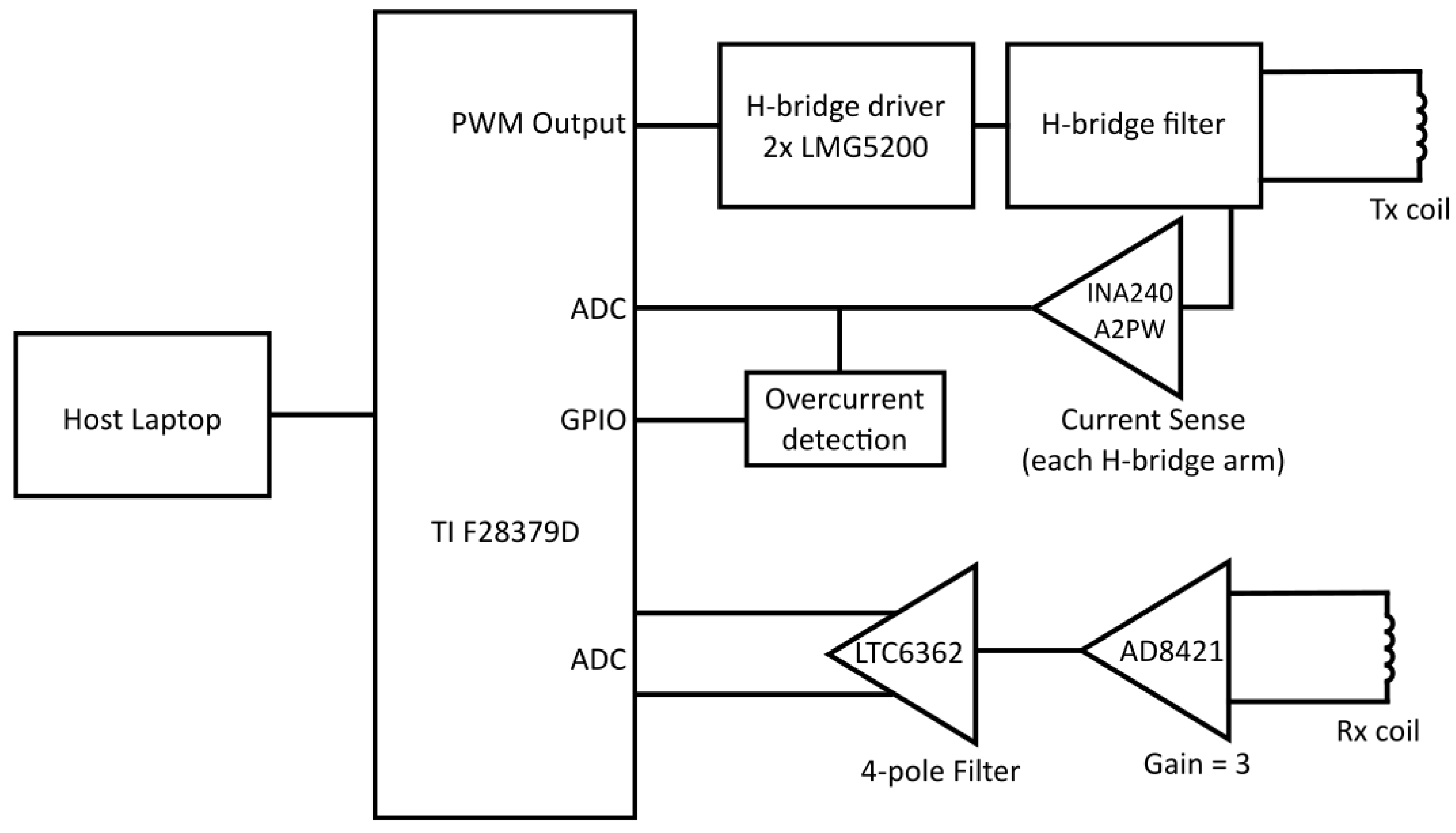

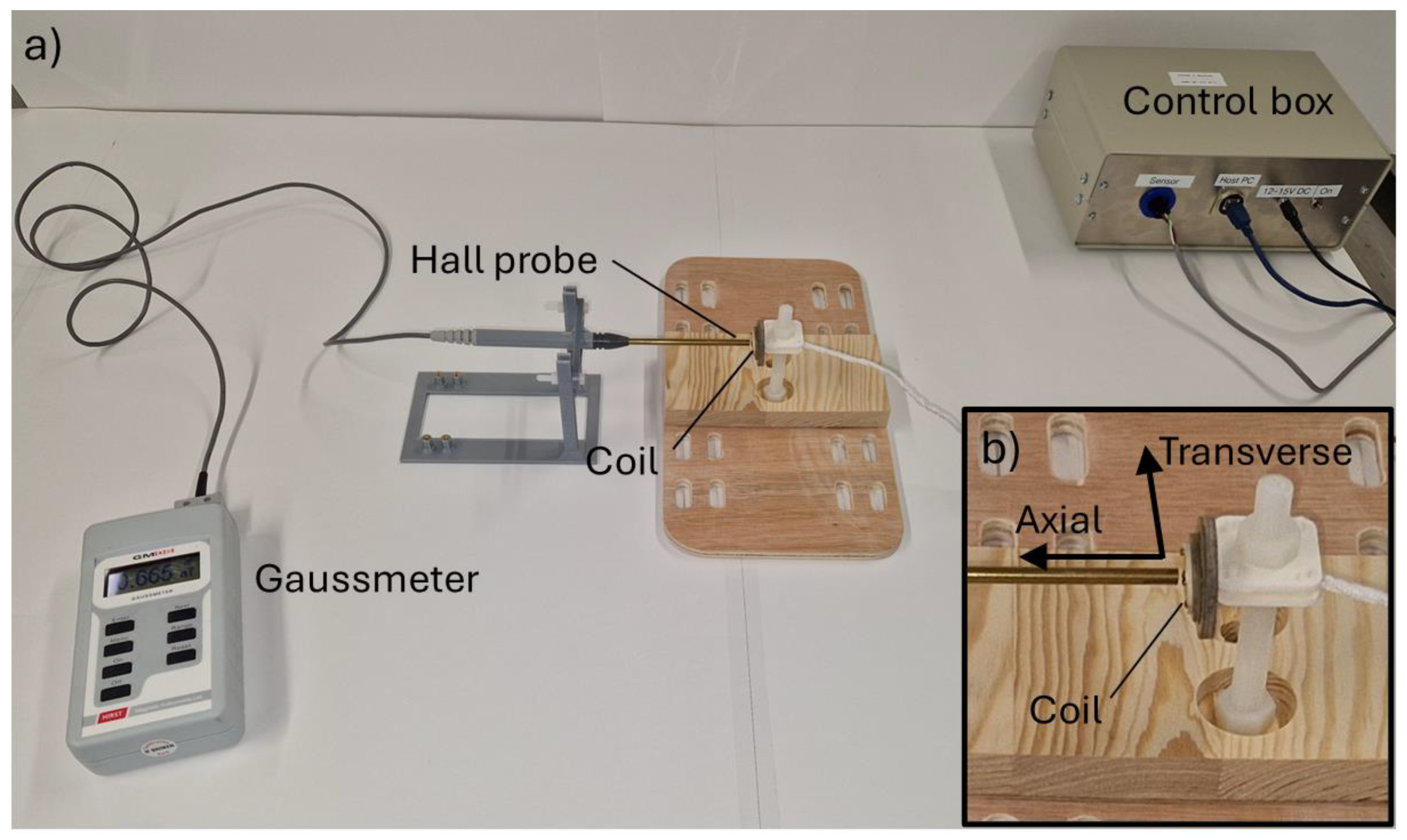

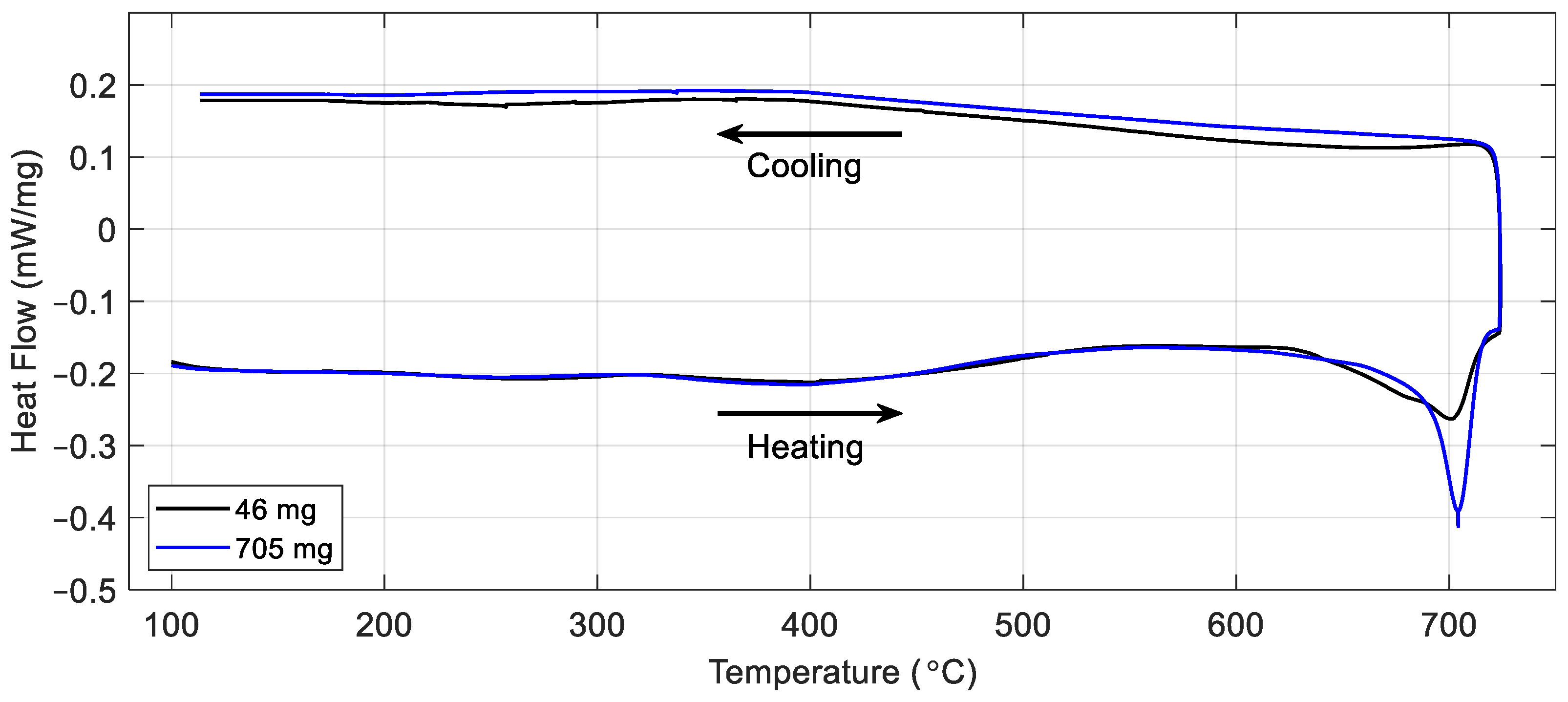

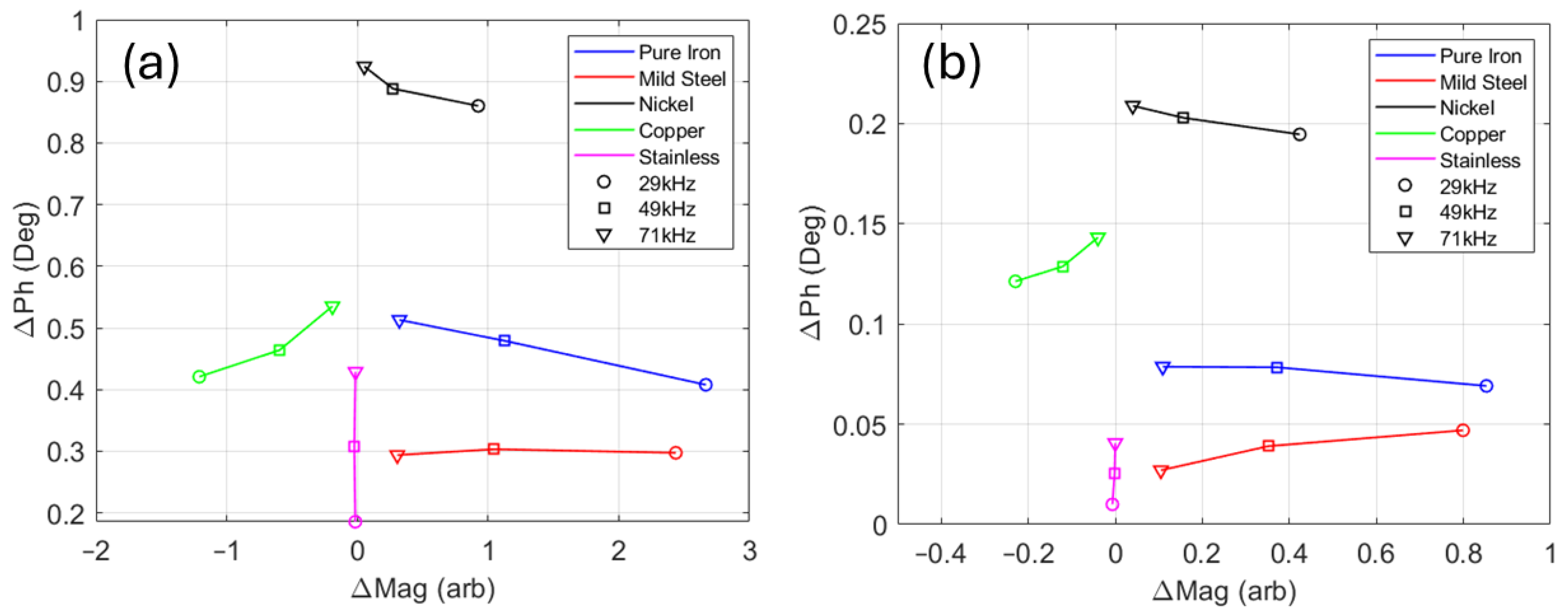
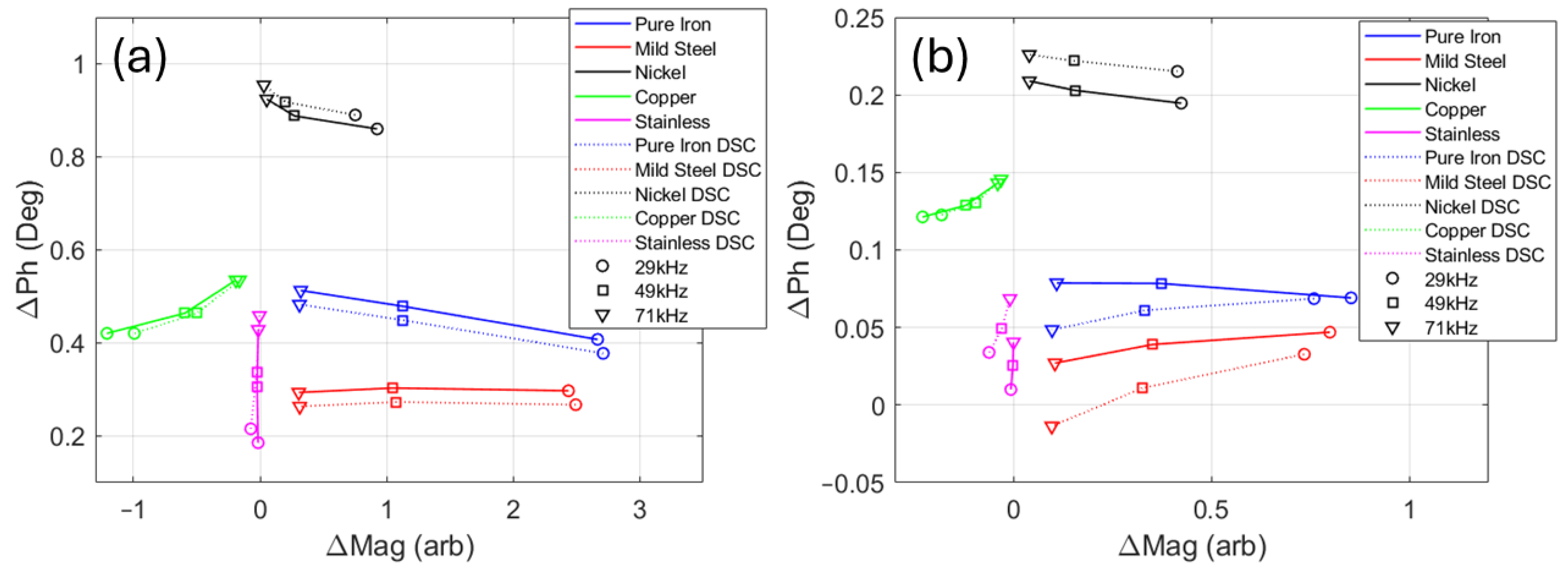
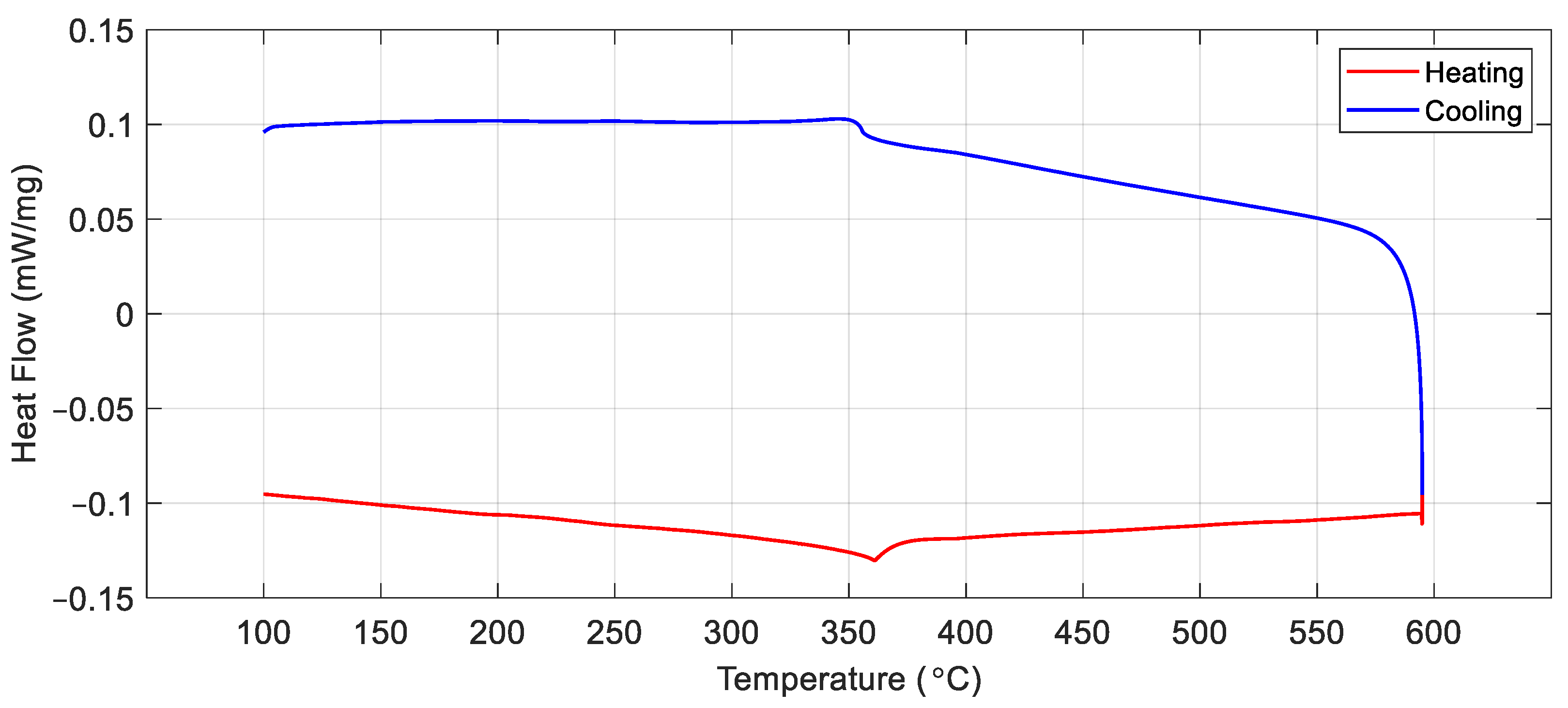
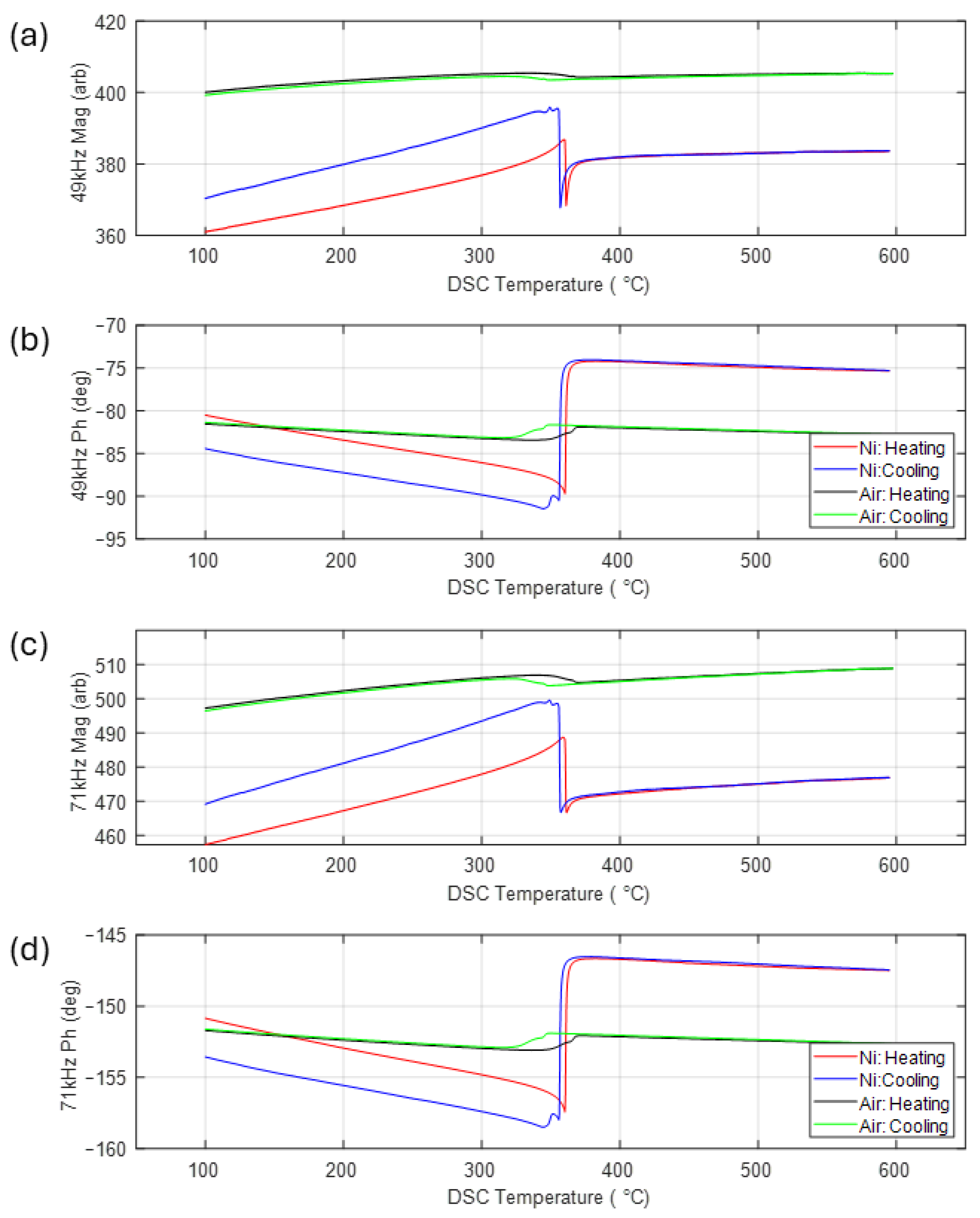
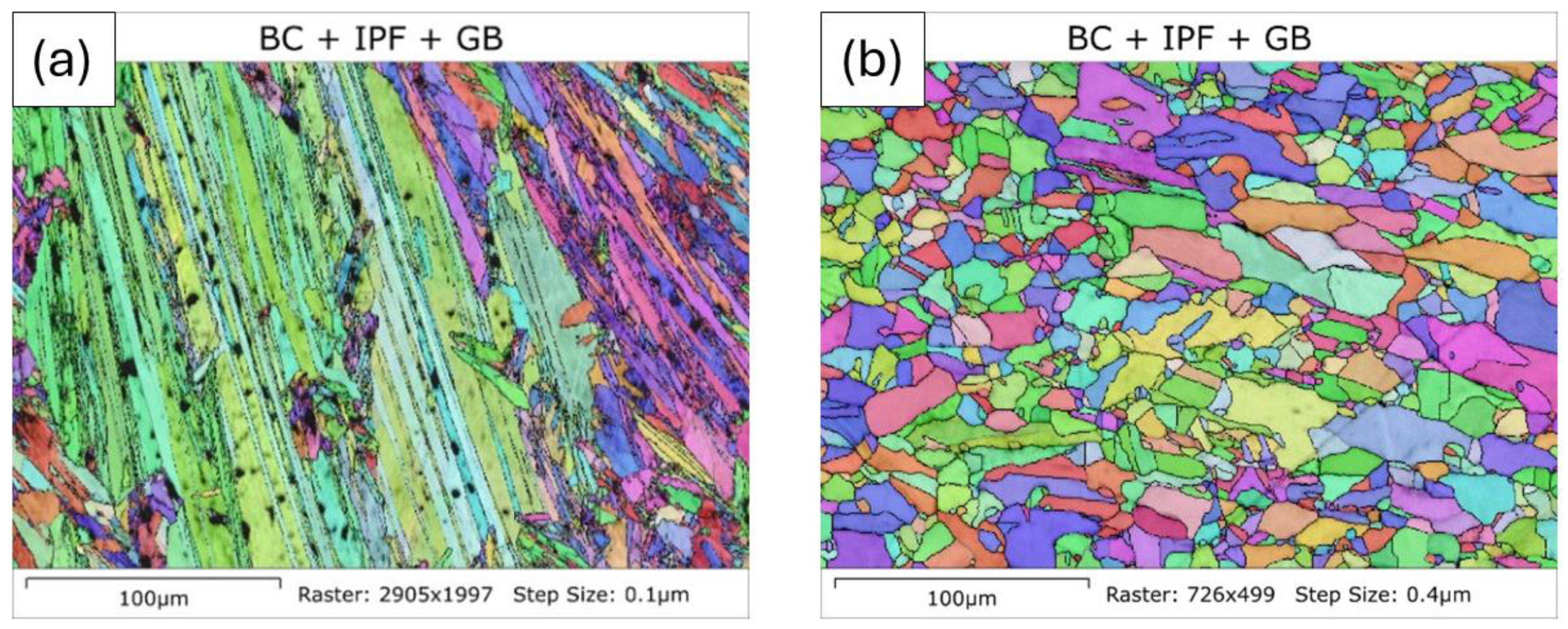
| Component Harmonic | Relative Magnitude | Relative Phase |
|---|---|---|
| 29 | 0.5 | 0.0 |
| 49 | 0.5 | 0.0 |
| Transmit Harmonic | RMS Magnetic Field [mT] | Relative Transmit Magnitude | |
|---|---|---|---|
| Axial | Transverse | ||
| 1 | 1.51 | 0.47 | 0.3 |
| 5 | 1.21 | 0.47 | 0.3 |
| 10 | 1.61 | 0.51 | 0.5 |
| 29 | 1.11 | 0.54 | 0.85 |
| 41 | 0.76 | 0.50 | 0.85 |
| 29 + 41 (50%—50%) | 0.66 | 0.48 | 0.85 |
| Material | Large Sample Size (mm) | Small Sample Size (mm) | Chemical Composition | Comments |
|---|---|---|---|---|
| Pure Iron | 6.41Ø × 2.96 | 2.94Ø × 2.98 | Fe ~99.8% | High permeability, medium conductivity |
| Mild Steel | 6.36Ø × 2.90 | 2.95Ø × 2.84 | Fe-0.15C-0.6Mn | High permeability, medium conductivity |
| Nickel | 6.41Ø × 2.90 | 3.07Ø × 2.90 | Ni ~99% | Medium permeability, medium conductivity |
| Copper | 6.25Ø × 3.01 | 3.05Ø × 2.77 | Cu ~99% | Diamagnetic, high conductivity |
| Stainless Steel (316) | 6.40Ø × 2.94 | 2.99Ø × 2.93 | Fe-16Cr-10Ni-2Mo | Paramagnetic, low conductivity |
| Med Steel (Fe-0.5C-6Mn) | 6.40Ø × 2.95 | 2.98Ø × 2.92 | Fe-0.5C-6Mn | Medium permeability, low to medium conductivity |
Disclaimer/Publisher’s Note: The statements, opinions and data contained in all publications are solely those of the individual author(s) and contributor(s) and not of MDPI and/or the editor(s). MDPI and/or the editor(s) disclaim responsibility for any injury to people or property resulting from any ideas, methods, instructions or products referred to in the content. |
© 2024 by the authors. Licensee MDPI, Basel, Switzerland. This article is an open access article distributed under the terms and conditions of the Creative Commons Attribution (CC BY) license (https://creativecommons.org/licenses/by/4.0/).
Share and Cite
Wilson, J.W.; Jolfaei, M.A.; Fletcher, A.D.; Slater, C.; Davis, C.; Peyton, A.J. Adaptation of a Differential Scanning Calorimeter for Simultaneous Electromagnetic Measurements. Sensors 2024, 24, 6077. https://doi.org/10.3390/s24186077
Wilson JW, Jolfaei MA, Fletcher AD, Slater C, Davis C, Peyton AJ. Adaptation of a Differential Scanning Calorimeter for Simultaneous Electromagnetic Measurements. Sensors. 2024; 24(18):6077. https://doi.org/10.3390/s24186077
Chicago/Turabian StyleWilson, John W., Mohsen A. Jolfaei, Adam D. Fletcher, Carl Slater, Claire Davis, and Anthony J. Peyton. 2024. "Adaptation of a Differential Scanning Calorimeter for Simultaneous Electromagnetic Measurements" Sensors 24, no. 18: 6077. https://doi.org/10.3390/s24186077
APA StyleWilson, J. W., Jolfaei, M. A., Fletcher, A. D., Slater, C., Davis, C., & Peyton, A. J. (2024). Adaptation of a Differential Scanning Calorimeter for Simultaneous Electromagnetic Measurements. Sensors, 24(18), 6077. https://doi.org/10.3390/s24186077







